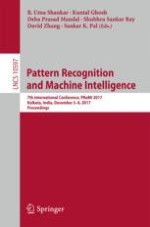2017 | OriginalPaper | Chapter
A New Method to Address Singularity Problem in Multimodal Data Analysis
Authors : Ankita Mandal, Pradipta Maji
Published in: Pattern Recognition and Machine Intelligence
Publisher: Springer International Publishing
Activate our intelligent search to find suitable subject content or patents.
Select sections of text to find matching patents with Artificial Intelligence. powered by
Select sections of text to find additional relevant content using AI-assisted search. powered by
Abstract
 )’ problem of bioinformatics, image analysis, high throughput molecular screening, astronomy, and other high dimensional applications makes the features highly collinear. In this context, the paper presents a new feature extraction algorithm to address this ‘large
)’ problem of bioinformatics, image analysis, high throughput molecular screening, astronomy, and other high dimensional applications makes the features highly collinear. In this context, the paper presents a new feature extraction algorithm to address this ‘large
 small n’ issue associated with multimodal data sets. The proposed algorithm judiciously integrates the concept of both regularization and shrinkage with canonical correlation analysis to extract important features. To deal with the singularity problem, the proposed method increases the diagonal elements of covariance matrices by using regularization parameters, while the off-diagonal elements are decreased by shrinkage coefficients. The concept of hypercuboid equivalence partition matrix of rough hypercuboid approach is used to compute both significance and relevance measures of a feature. The importance of the proposed algorithm over other existing methods is established extensively on real life multimodal omics data set.
small n’ issue associated with multimodal data sets. The proposed algorithm judiciously integrates the concept of both regularization and shrinkage with canonical correlation analysis to extract important features. To deal with the singularity problem, the proposed method increases the diagonal elements of covariance matrices by using regularization parameters, while the off-diagonal elements are decreased by shrinkage coefficients. The concept of hypercuboid equivalence partition matrix of rough hypercuboid approach is used to compute both significance and relevance measures of a feature. The importance of the proposed algorithm over other existing methods is established extensively on real life multimodal omics data set.